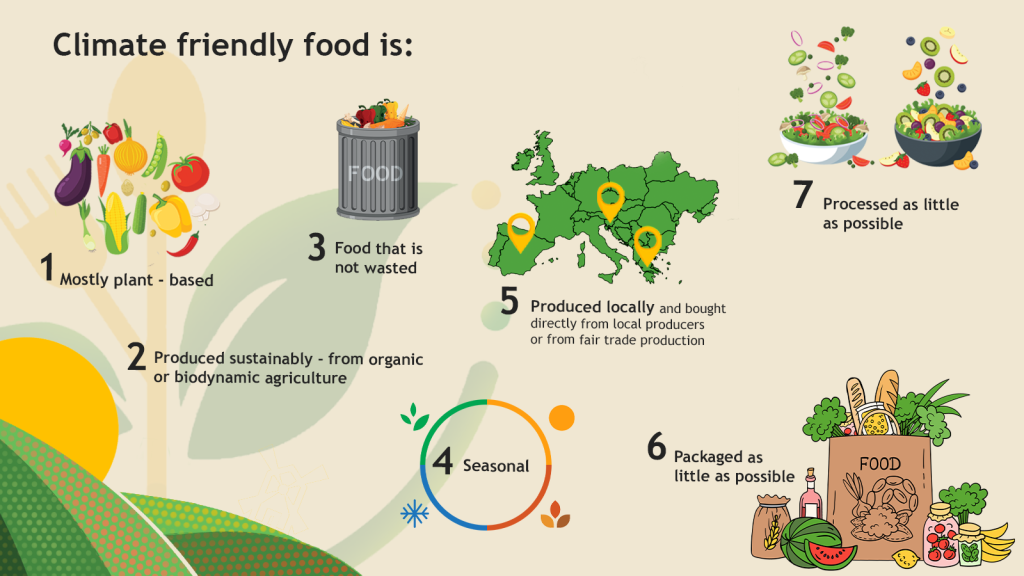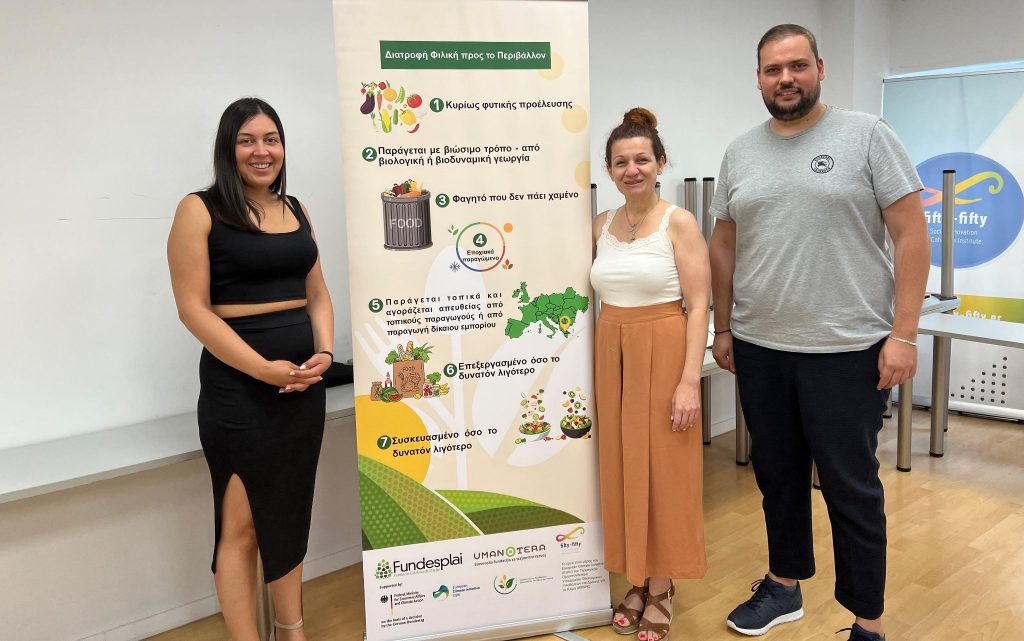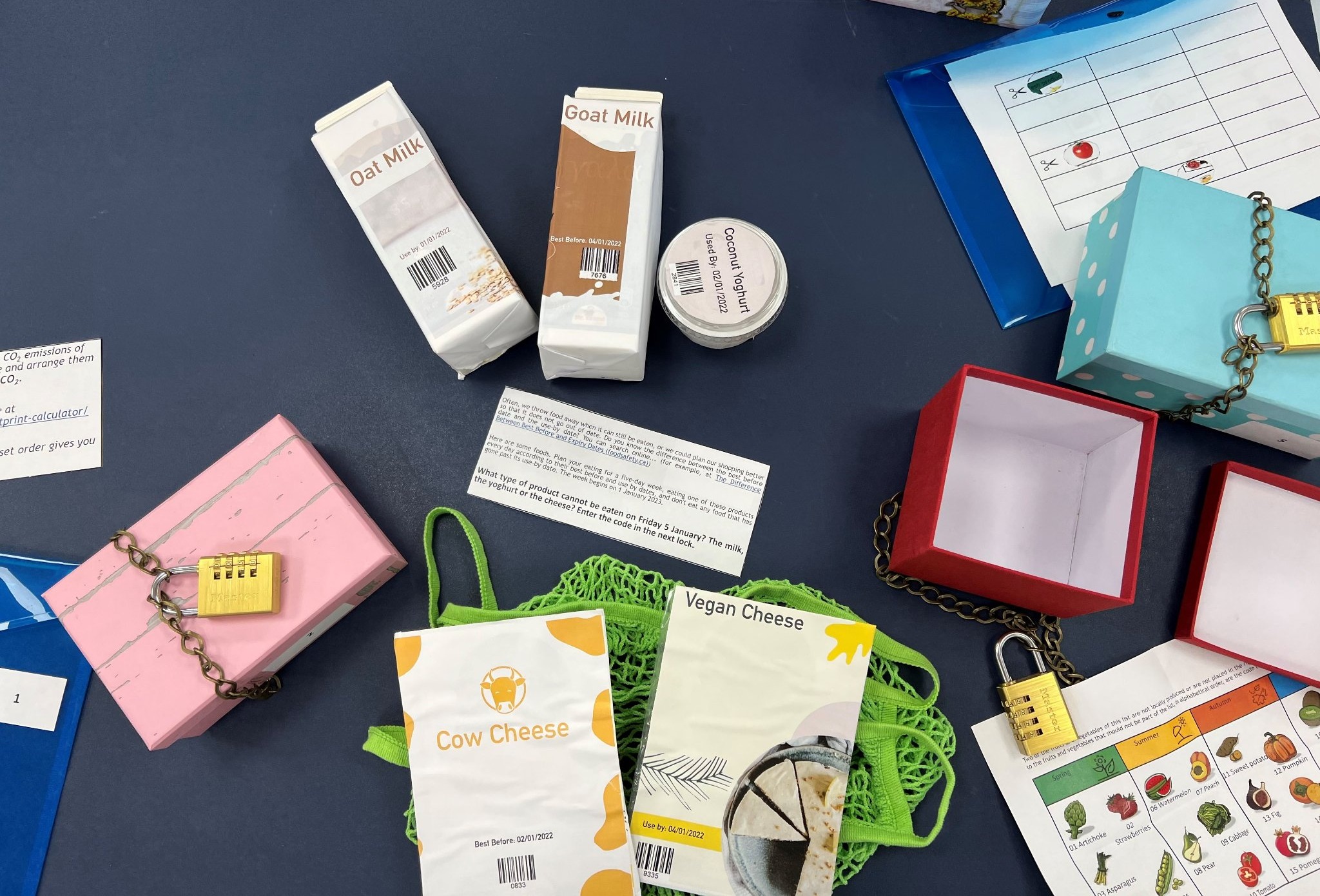Climate Action to the Table
Website :
Project Details: 81277329/2
Programme: European Climate Initiative EUKI

Timeline: 01.09.2021 to 28.02.2023
Project Description
1. Towards better food choices and a sustainable food system
The food system is at the heart of the great challenges humanity now faces. According to United Nations projections, by 2050 the world’s population will reach nearly 10 billion people, all of them with the same need to eat. The right to food is a basic human right; food is essential for human survival and health, but it is also a complex topic that impacts our society and the world. Currently, the global food supply system accounts for a third of all anthropogenic greenhouse gas emissions and is thus one of the main causes of the climate crisis in which we found ourselves (Crippa et al., 2021). In addition, the current way of producing food leads to the accelerated disappearance of biodiversity, which threatens the existence of human civilization (Benton et al., 2021).
The predominant way of producing and consuming food is not only bad for the planet, but also for our health. It is a leading cause of non-communicable diseases (such as cardiovascular disease, cancer, diabetes) and therefore the cause of many premature deaths around the world (Benton et al., 2021). The good news is that recent studies indicate that it is possible to meet the global food demand in a healthy and sustainable way, if adjustments are made in the way we produce and consume food (EAT LANCET Summary report, 2019). In fact, most of the eating habits that are good for the planet are also good for our health and vice versa. Food, human health and climate are inextricably connected issues and a successful transition to a more sustainable future requires deep changes in the way global food systems work.
Food is a common topic for everyone. It interconnects economic, environmental, cultural and social aspects of sustainable development and is a central axis of action in the fight against the climate emergency.
We are living in a climate emergency that affects and threatens several life forms. It is a decisive decade, where rapid and sustained emissions reductions are needed to limit global warming. To achieve this, transforming the food system is key. And the need for people to make better food choices has never been more urgent.
In general, the connection between food systems and climate change is not being widely addressed in educational spaces. Among the reasons for that is the fact that food has not been a central topic on the climate change debate and the lack of resources available to help teachers present this complex topic to their students. Therefore, we have created this guide, to inspire and equip educators with different tools and activities to bring this vital subject into their classrooms. The aim of this set of activities is to encourage children and young people to adopt eating habits that are good for their health and for the planet. Furthermore, we hope this guide will support educators to empower their students to be agents of change in their families and communities.

This infographic was produced as part of the European Climate Initiative (EUKI). EUKI is a project financing instrument by the German Federal Ministry for Economic Affairs and Climate Action (BMWK).
It is important to follow 7 principles that determine sustainable and environment- friendly food. These are:
1 Mainly plant-based
The overconsumption of animal protein is one of the main causes of CO2 emissions and other greenhouse gases. Reducing the current consumption of meat is possible because the proteins we need can also be obtained from plant-based foods. There is growing scientific evidence of the benefits for our health and the environment of consuming more plant-based foods, such as vegetables, fruit, pulses, nuts, seeds and whole grains. Choosing a diet with less animal protein is essential for battling climate change and improving our health and that of the planet.
Currently, the food system is responsible for 30 % of global greenhouse gas (GHG) emissions. Food of plant origin has a much lower carbon footprint than food of animal origin (meat and milk), as livestock farming is the largest source of GHG emissions in agriculture. According to the United Nations (FAO, 2013), livestock farming produces 14.5 % of the world’s total GHG emissions. This figure exceeds the direct emissions of all the cars, lorries and aeroplanes in the world put together. Besides that, it has also a huge impact on land occupation, deforestation, and water consumption. Much of the livestock feed comes from countries where tropical forests, which are the most important sinks of CO2, are cut down as a result of its production. Therefore, it is an activity that very significantly contributes to the climate crisis.
2 Produced sustainably
The conditions under which food products are prepared are crucial. Whenever possible, we should choose products grown on farms that are committed to quality and to the principles of organic farming and sustainability. Supporting local organic farming is a strategy to lower the carbon footprint of the food system on the planet and has minimal impact on the environment as it does not allow the use of mineral fertilizers and synthetic pesticides (which have harmful effects on soil, air, water and biodiversity).
To achieve environmentally friendly and quality production, organic farms eliminate the use of fertilisers and synthetic plant protection products. To regenerate the soil, they cultivate fodder legumes, use nutrients of plant origin and manure from organic farms. To protect plants against disease, organic farms use natural techniques and products, among other practices. Agricultural formulas are being developed that aim to make greater environmental protection compatible with higher levels of agricultural efficiency. These are characterised by the use of techniques that reduce CO2 emissions and water use, minimise energy consumption, limit the use of fertilisers and promote circular the economy.
3 Reduce food waste
Enough food is produced to feed the entire world population, but we have a broken food system that, rather than responding to peoples’ nutritional needs, responds to market logic. We waste a massive amount of food that isn’t consumed, while around 800 million people suffer from an insufficient and poor diet (FAO, 2013).
Waste represents an enormous loss of resources, not only food but also natural resources: water, land use and energy consumption. It is also responsible for 10 % of greenhouse gas emissions as during food’s decomposition, methane is released, which is a very potent greenhouse gas. In fact, if food waste were a country, it would be the third-largest emitter, after China and the United States (FAO, 2013).
There is waste during every stage of the food chain system: from production in the fields, processing of the food, its sale and distribution to the actual moment of consumption. However, almost 40 % of waste in the entire chain occurs in homes, where there is an enormous opportunity for us to have an impact (FAO, 2013).
4 Seasonal
We have built a global industrial production system that provides us with food from anywhere in the world at any time of year. Locally grown food is an environmentally responsible option, especially if we choose food in its natural season.
By choosing seasonal food, we contribute to reducing greenhouse gas emissions from storage and processing intended to slow down ageing. By buying seasonal food, we also avoid buying products from heated greenhouses. These are big consumers of energy, and if this is not produced from renewable sources, they are also a big source of greenhouse gas emissions.
5 Local and bought directly from local producers or from fair trade
Large distances between production and consumption mean the use of a lot of energy and require extensive infrastructure. Buying locally and buying seasonal are two sides of the same coin and a chance to renew the connection between town and country, and to promote respect for the source of our food and the people who produce it.
The huge distance between production and consumption means an enormous use of energy and the construction of many infrastructures. This system causes a loss of
regional food sovereignty and encourages unfair relations within the food chain, benefiting companies in the sector with more economic power. Eating consciously involves asking where what we eat comes from, how it was made and under what conditions, and why we pay a certain price to buy it. It means taking control of our dietary habits and choosing foods that have the least environmental and social impact. With some foods, e.g. with coffee, tea and chocolate, we cannot stock up on local produce. When buying food from other parts of the world, we choose certified food that follows all principles; Fair Trade products for example, because we support fair and stable pay for smallholders in the global South, safe and healthy working conditions for food production, a ban on child labour, gender equality in pay and decision-making, and in most cases also more environmentally friendly food production.
6 Minimally packaged
The amount of packaging used for food has skyrocketed in recent years. We unnecessarily over-package and wrap food in the name of our safety and convenience, often in single-use packaging and mostly in plastic, due to its useful characteristics: lightweight, highly resistant, flexible, etc.
Plastic is an almost indestructible material: it can take up to 1000 years to decompose and most plastic items will never completely disappear; they simply get smaller and smaller. If plastic becomes waste and slowly decomposes in landfills or is incinerated in incinerators, it causes greenhouse gas emissions. A large amount of plastic also ends up in the sea, harming birds, marine mammals and fish, as well as reaching our plates in the form of microplastics. By consuming food that is packaged as little as possible we contribute to fight against this huge environmental challenge.
7 Minimally processed
The consumption of processed and ultra-processed foods has increased exponentially over recent decades. According to UNICEF, the incidence of childhood malnutrition is rising because of the consumption of products high in fats and sugars, such as fast food and snacks.
Aided by advances in technology, the food industry has promoted ultra-processed foods. These products are less nutritious than fresh food and continuous, long-term consumption has harmful consequences for our health. They also have a considerable environmental impact. Therefore, by deciding to consume as little processed food as possible, we are not only taking care of our health but also contributing to reducing greenhouse gas emissions from these industrial processes, which are often energy intensive.
For a successful transition to a climate-neutral society, it is important that we follow all seven guidelines for a more climate-friendly diet as much as possible. Among the listed measures, the decision to eat mainly plant based food is the one with the greatest individual impact.
Project Activities :
- Output I: Escape room (physical and digital) to encourage youth to put in practice their reflection and problem-solving skills and sense of urgency concerning food sustainability by playing in an escape room.
- Output II: Cycle of conferences to increase awareness on sustainable food consumption among adults.
- Output III: Educational toolkit and training to equip educators with needed methods and skills to carry out educational activities on food sustainability for children and youth. Click here to access the Toolkit (Click Here)
CATTT Partners



CATTT Meetings:
We had the pleasure to host Pia, a project officer from EUKI – European Climate Initiative in our office in Thessaloniki , to talk about our project “Climate Action to the Table”.



CATTT Downloadable Files:

